Perry Mason in The Case of the Lucky Legs
One of the reasons I watch old movies is that even with faintly-remembered, mildly-OK films, you can often get interesting glimpses into a time that you've had no first-hand experience with. Products, technology, and everyday-life stuff that have been forgotten over the decades, but are most easily observed through classic Hollywood films.
Which brings me to The Case of the Lucky Legs. Released in 1935, it was one in a series of Perry Mason mysteries that starred Warren William.
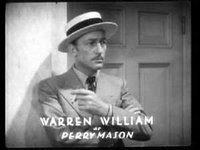 Think of Warren William was sort of a B-version of John Barrymore. His career specialty was in playing upper-class manipulators and cads. In this film, he's the famous hero/lawyer on a case that involves a thousand-dollar "Beautiful Legs" competition, and a dead body on a bathroom floor. It's a fairly standard 30's murder mystery, brightened by wry banter between Perry and his secretary, and culminating in a roundup of all the characters as Perry adds everything up, forcing the murderer to implicate himself. This final scene is no ordinary one though, in that the dialogue happens in Perry's office (then moves to his doctor's office), all while he's getting a physical examination.
Think of Warren William was sort of a B-version of John Barrymore. His career specialty was in playing upper-class manipulators and cads. In this film, he's the famous hero/lawyer on a case that involves a thousand-dollar "Beautiful Legs" competition, and a dead body on a bathroom floor. It's a fairly standard 30's murder mystery, brightened by wry banter between Perry and his secretary, and culminating in a roundup of all the characters as Perry adds everything up, forcing the murderer to implicate himself. This final scene is no ordinary one though, in that the dialogue happens in Perry's office (then moves to his doctor's office), all while he's getting a physical examination.
At the doctor's office, the suspects, and various other characters are treated to Perry getting an x-ray from his doctor, who's decked out in goggles, a lead vest, and heavy gloves.
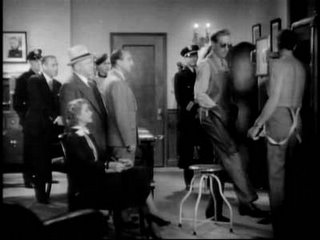 As Perry continues to regale the audience (one of whom IS the killer), the doctor swings out the x-ray machine viewscreen...
As Perry continues to regale the audience (one of whom IS the killer), the doctor swings out the x-ray machine viewscreen...
 He shuts off the lights, and gives the audience a more personal view of our famous lawyer.
He shuts off the lights, and gives the audience a more personal view of our famous lawyer. I had never been exposed to the way that x-rays used to be done, except through the occasional Bugs Bunny cartoon (usually Bugs vs. some sort of mad scientist), but I had always thought that the depiction of x-ray machines in these cartoons was creative exaggeration.
I had never been exposed to the way that x-rays used to be done, except through the occasional Bugs Bunny cartoon (usually Bugs vs. some sort of mad scientist), but I had always thought that the depiction of x-ray machines in these cartoons was creative exaggeration.
It's interesting to see how casual the treatment of low-level radiation was. Of course it was a time when it wasn't unusual to see one of these at your neighborhood department store. A time when people thought nothing of putting little Timmy's feet in a large wooden box to see if the bones in his feet were getting squished by his new Buster Brown's.
To be honest, now people are maybe just a little too worried about such things. Well, the pendulum swings.
One last thing; the man playing Perry's doctor would later play an important role in history when, while admitted into the alcoholic's ward of an LA hospital, he tipped off the authorities to the wherabouts of the queen's nest, during the Giant-Ant Crisis of 1954.
Giant ants, created by heavy doses of...radiation.
An Eye for Annai
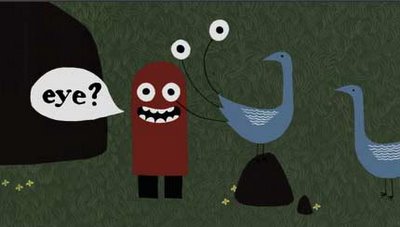 Watch this teriffic animated short at Burst of Beaden (via Drawn!) It's called An Eye for Annai and is one of the best combinations of design, music, and humor that I've seen in a very long time. It's free of many of the pretensions often found in student animated films. A real pleasure.
Watch this teriffic animated short at Burst of Beaden (via Drawn!) It's called An Eye for Annai and is one of the best combinations of design, music, and humor that I've seen in a very long time. It's free of many of the pretensions often found in student animated films. A real pleasure.
Murders in the Rue Morgue
I've been going through the newly released Bela Lugosi Collection lately and watched Murders in the Rue Morgue for the first time. Not a great movie, but satisfyingly atmospheric, with interesting camerawork. It's skillful enough not to overstay it's welcome with a 60 minute runtime, and not at all a bad choice to get you in the mood for the run-up to Halloween. Besides, there's a monkey in it (Closeups only. Actor in an ape-suit for wide shots.), so it has that going for it.
Here's an example of early-30's, backlot-fantasy environments that old-Hollywood did so well:
 Paris, 1845. Hazy. Nostalgic. Soot-covered. You can really feel the bleed-over from silent-era filmmaking in shots like this.
Paris, 1845. Hazy. Nostalgic. Soot-covered. You can really feel the bleed-over from silent-era filmmaking in shots like this.
The villain of our story is, as you could probably guess, Bela. A sideshow carny/mad scientist who abducts wayward young women for unsavory experiments utilizing ape plasma. Crazy bastard. Here's Dr. Mirakle (pronounced Meer-ackle) luring one of his unfortunate victims:
 Known only as a "Woman of the Streets". It's no trick to guess what her line of work is...
Known only as a "Woman of the Streets". It's no trick to guess what her line of work is...
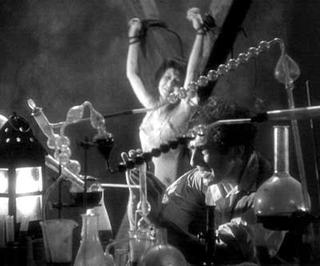 or what her eventual fate will be.
or what her eventual fate will be.
The hero of our story works in the Rue Morgue, and lives in this craaaazy apartment with his tubby roommate.
 Nice digs. I just wonder if it was a common practice in 19th Century France, for tenants to draw cartoons on the walls.
Nice digs. I just wonder if it was a common practice in 19th Century France, for tenants to draw cartoons on the walls.
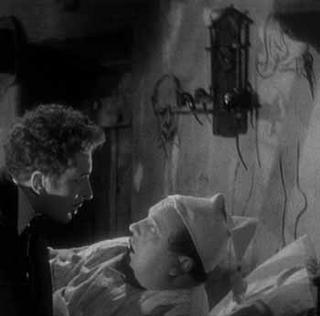 Is that the kind of thing that would bother a 19th century landlord? I mean, if you've managed to dodge high infant mortality rates, diptheria, bad dentistry, and all the other now forgotten woes, would you really be all that bothered by a little graffiti? Yeah, probably.
Is that the kind of thing that would bother a 19th century landlord? I mean, if you've managed to dodge high infant mortality rates, diptheria, bad dentistry, and all the other now forgotten woes, would you really be all that bothered by a little graffiti? Yeah, probably.
Anyway, back to our favorite "Woman of the Streets":
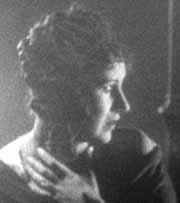
So, does she seem the least bit familiar?
C'mon, you already guessed her line of work. You might possibly recognize her name.
No?
Okay, fine. Three clues. One. Two. Three.
With a name like Pangborn....
When I returned to caricaturing for fun recently, I wanted to take it easy on myself, and not start right out with well-known, predictably handsome or beautiful Hollywood stars (Correction: Okay, I did start out with an attempt at caricaturing Cary Grant, who frustratingly kept looking a little too much like George Clooney.), so I decided to focus on personalities that were almost living-caricatures to begin with. One of the first caricatures that I attempted was of Franklin Pangborn.
What can you say about someone with a face like this:
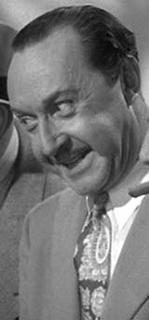 Franklin Pangborn was the type of actor born to play fussy, put-upon, continually exasperated characters...very...very...well.
Franklin Pangborn was the type of actor born to play fussy, put-upon, continually exasperated characters...very...very...well.
I first became aware of Pangborn as one of Preston Sturges' most frequently used character actors. Sturges always found ways to write memorable scenes for his friends, and one of my favorites is Pangborn's "Chairman of the Reception Comittee" at the beginning of Hail the Conquering Hero.
The scene is masterful in showing an over-organized fuss-budget, slowly losing control over the detailed plans in his head, as various bands and a small boy with a trumpet argue over who gets to play "Hail the Conquering Hero" and "Into the Arms of Mother" for returning "war hero" Eddie Bracken. Naturally, other people pop into the frame to suggest other songs ("Let Me Call You Sweetheart"?)
Of course, every song does get played...all at the same time. Which leaves Pangborn hopping up and down, yelling "Not yet! Not yet!!!", and frantically blowing a whistle.
Apart from Sturges, Pangborn was also very memorable in slightly more subdued roles such as J. Pinkerton Snoopington in The Bank Dick with W.C. Fields, or the Theatrical Producer in Ernst Lubitsch's Design for Living, as well as dozens of other films in the 30's and 40's.
Also, like many men of his time, he was a veteran of World War I.
The idea of Pangborn fighting off a hoarde of bloodthirsty Huns, seems almost incomprehensible. Incomprehensible, but most certainly...funny.
Okay, here's the drawing.
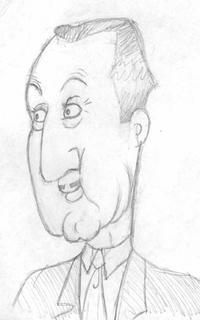
Goes by the name of Rocky. Alias: Bob Steele?
Considering this is my first official post, I figured I'd address a theory I've had for several years concerning this fella: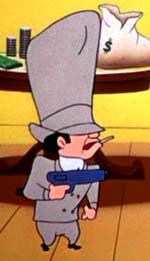 You probably recognize him as the Looney Tunes character named Rocky. He was a gangster character that first appeared in the Friz Freling cartoon Golden Yeggs (1950), and was a semi-frequent foil for both Daffy Duck and Bugs Bunny.
You probably recognize him as the Looney Tunes character named Rocky. He was a gangster character that first appeared in the Friz Freling cartoon Golden Yeggs (1950), and was a semi-frequent foil for both Daffy Duck and Bugs Bunny.
I'm a big fan of the Howard Hawks film The Big Sleep, and after a few viewings I noticed that the character of the hitman, Canino, bore a similarity to Rocky. Canino was played by Warner Brothers character actor Bob Steele, as seen in the picture below.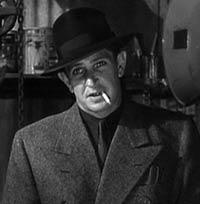 Dangling cigarette. Check. Fedora. Check. Long coat. Check.
Dangling cigarette. Check. Fedora. Check. Long coat. Check.
He kind of looks like Rocky, but it is a pretty standard depiction of a gangster.
I figured the similarities were just a coincidence, until I watched the John Wayne movie Rio Bravo (Also directed by Howard Hawks, some 15 years later.), and lo-and-behold, who shows up in a small role, but Bob Steele!
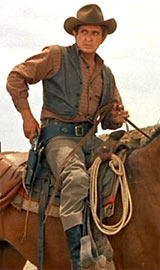 Then I saw this shot:
Then I saw this shot:
 Look at the guy! Bob Steele was a really small man. According to the IMDB, 5-foot, 5-inches.
Look at the guy! Bob Steele was a really small man. According to the IMDB, 5-foot, 5-inches.
Both The Big Sleep and Rio Bravo were made at Warner Brothers, and I think it's very plausable that Rocky's creators saw Steele's memorable hit-man performance, had first-hand knowledge of Steele's real life stature, and saw the comedic potential in the idea of a diminuitive tough-guy as a foil for their star characters.
I've bounced this idea off of cartoon historian Jerry Beck (via his cartoon history forum), but unfortunately, the inspiration for Rocky never came up in any of his interviews with Friz Freling. Freling died ten years ago, and any interviews with him now would be pretty one-sided.
Bob Steele had a very long and varied career. He started out as a child star in silent movies, and eventually became a pretty popular B-western hero in the 30's. In his later life he mainly got work as a character actor and was a regular on the 1960's Warner Brothers TV show, F Troop, in which he had a regular role as Trooper Duffy.
Introduction
This website will cover my interests in classic movies, television, animation, and caricature, as well as (although, probably less frequently); history, war, capitalism, and freedom. I think of this blog as my right-brained interests mashed-together with my left-brained interests. Some may find (If anyone actually ends up reading this stuff.) the combination of these subjects to be somewhat peculiar.
I do not.
I believe that the latter group is completely necessary for the former group to completely thrive. (Besides, it's my website, and I'll prattle on about anything I darn well please.)
I'm not quite sure when my first official post will be, but...stay tuned.
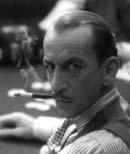
-Daniel
 Think of Warren William was sort of a B-version of John Barrymore. His career specialty was in playing upper-class manipulators and cads. In this film, he's the famous hero/lawyer on a case that involves a thousand-dollar "Beautiful Legs" competition, and a dead body on a bathroom floor. It's a fairly standard 30's murder mystery, brightened by wry banter between Perry and his secretary, and culminating in a roundup of all the characters as Perry adds everything up, forcing the murderer to implicate himself. This final scene is no ordinary one though, in that the dialogue happens in Perry's office (then moves to his doctor's office), all while he's getting a physical examination.
Think of Warren William was sort of a B-version of John Barrymore. His career specialty was in playing upper-class manipulators and cads. In this film, he's the famous hero/lawyer on a case that involves a thousand-dollar "Beautiful Legs" competition, and a dead body on a bathroom floor. It's a fairly standard 30's murder mystery, brightened by wry banter between Perry and his secretary, and culminating in a roundup of all the characters as Perry adds everything up, forcing the murderer to implicate himself. This final scene is no ordinary one though, in that the dialogue happens in Perry's office (then moves to his doctor's office), all while he's getting a physical examination. As Perry continues to regale the audience (one of whom IS the killer), the doctor swings out the x-ray machine viewscreen...
As Perry continues to regale the audience (one of whom IS the killer), the doctor swings out the x-ray machine viewscreen... He shuts off the lights, and gives the audience a more personal view of our famous lawyer.
He shuts off the lights, and gives the audience a more personal view of our famous lawyer. I had never been exposed to the way that x-rays used to be done, except through the occasional Bugs Bunny cartoon (usually Bugs vs. some sort of mad scientist), but I had always thought that the depiction of x-ray machines in these cartoons was creative exaggeration.
I had never been exposed to the way that x-rays used to be done, except through the occasional Bugs Bunny cartoon (usually Bugs vs. some sort of mad scientist), but I had always thought that the depiction of x-ray machines in these cartoons was creative exaggeration.













